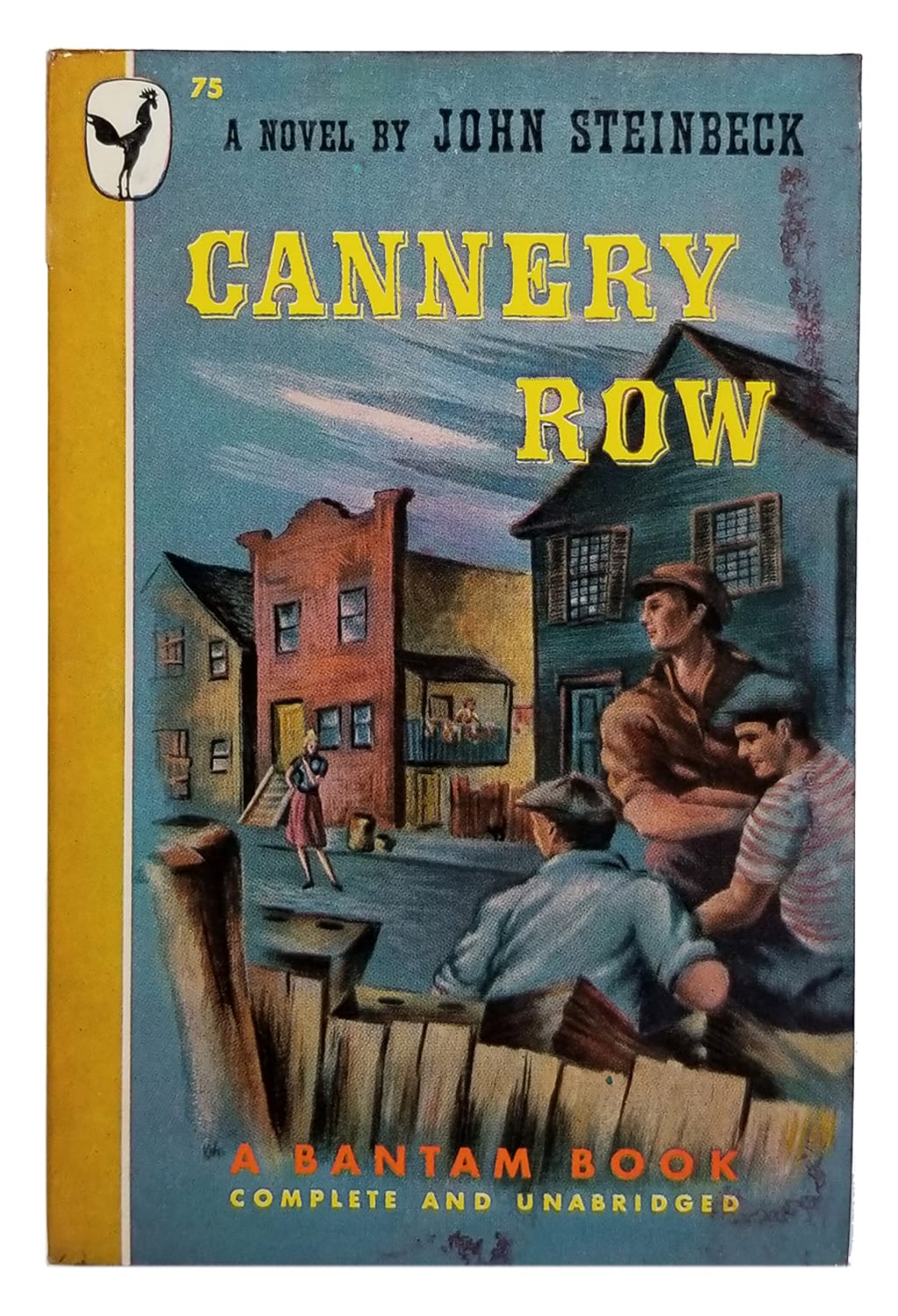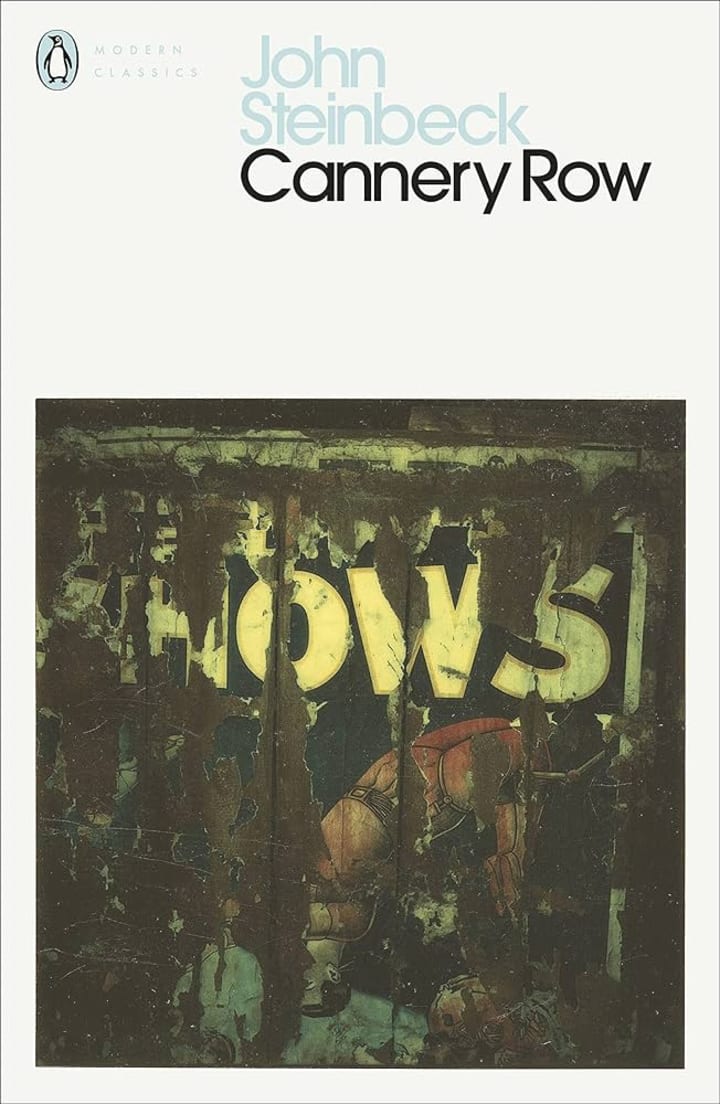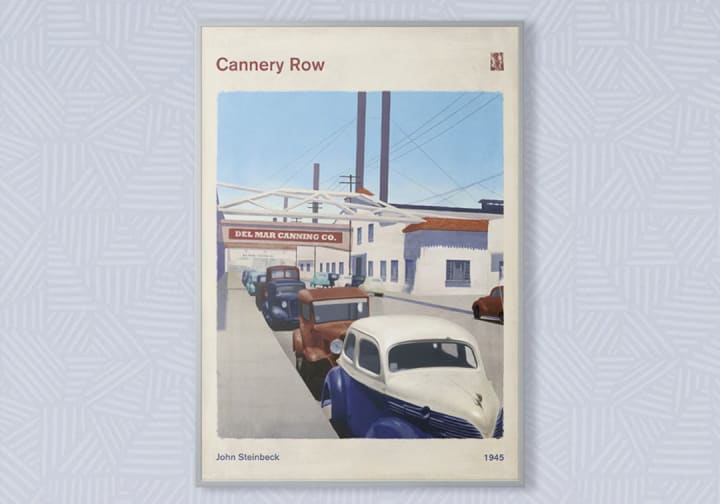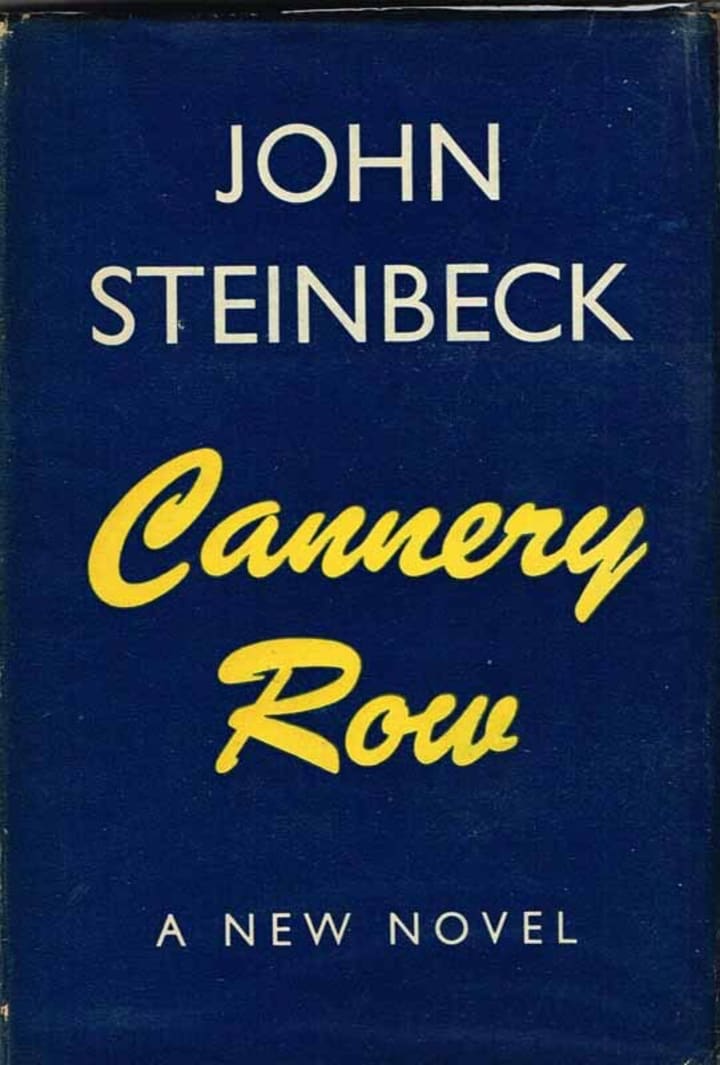Cannery Row by John Steinbeck
Why It's a Masterpiece (Week 15)

Published in the January of 1945, Steinbeck’s rowdy novel about life on Cannery Row during the Great Depression is probably best known for its host of characters and rambunctious plots that shoot off in every direction and envelope each aspect of society existing in that space. Possibly my favourite Steinbeck novel, this book has the ability to make you laugh, make you upset and make you angry, fearful and excited all in the space of just over 200 pages. One of Steinbeck’s shorter novels, it packs a powerful punch about life and camaraderie, nostalgia and superficiality during one of the most financially turbulent times in history.
Here’s a fun fact for you: it was not the book that was named after the avenue, but the other way around. Previously, the road had been known as Ocean View Avenue but was renamed Cannery Row in honour of Steinbeck’s novel and how famous it had become.
Plot

This book stars a whole host of brilliant characters and the main plot line refers to a group of derelict men called ‘Mack and the Boys’ who are throwing a party for their friend Doc. The entire community becomes involved in it and eventually, the party will rage out of control ruining the laboratory where Doc works and his home. Mack’s idea is to throw another party and make it actually work. In the midst of this is a mixture of characters, each telling their own stories, each walking in and out of the novel. Lots of these subplots happen all at the same time and showcase differences in life on Cannery Row.
We have Lee Chong - a neighbourhood grocery store owner who is never really paid with any actual money, but is given collateral instead. For example, he is gifted a warehouse which he then rents out for a minimum fee to Mack and the Boys. We then have Doc - a biologist who helps Mack and the Boys out when they are in trouble and asks for nothing in return. Dora Flood is the operator of the Bear Flag restaurant who often has more than a wise word to say - we see Mack go to her when he is in trouble to talk about things. Hazel, Eddie, Jones etc. are all part of Mack and the Boys and have varying levels of expertise in things such as bartending and fixing cars.
Throughout the book, we see people commit suicide, we see people get angry with other people and fights break out, we see a Chinaman, football, the Palace Flophouse, a long and depressing drive around California, people fixing a car, prostitution and so much more. This book is one of the most expansive but short books in John Steinbeck’s entire career and the characters get revisited in his novel ‘Sweet Thursday’ where we will see Doc return from the war, feeling different about the whole Western Biological Laboratory work. We then get access to the ‘after’ stories of all of these characters including the deaths of some of the important ones and new characters who are about and causing trouble.
Into the Book

This book, as you can imagine, holds a whole host of themes, motifs and symbols within - all of which create new and indelible meanings for all of its characters (and there are a lot of them). First of all, there is the theme of socialisation. The first two characters we meet are Horace Abbeville and Lee Chong and so, with this we see two opposing sides of the socialisation scale: one person who is possibly the most social person on Cannery Row and the second one who may be socialising, but feels ostracised. Long story short, Horace Abbeville commits suicide. One thing that we do not find during the conversation he has with Lee Chong is a man who is actually going to go to the lengths to kill himself because of the position he is in. He owes Lee Chong money, but Lee Chong being well socialised with in Cannery Row, doesn’t think too much of it and doesn’t get nasty about it. Though he knows that Horace owes him money, he smiles ‘agreeably’ throughout the conversation. Lee Chong eventually resolves that though Horace had people around him, he didn’t have a single friend in the world. This is where it’s important to understand why Mack and the Boys stick together - they have nothing but they have each other. The one thing they have in common is that they have nothing and they have nobody and that is enough. None of them are going around committing suicide and yet, a man who had property during this time killed himself. It’s an important lesson that underlines the novel and adds meaning to the experiences of people meeting and interacting with each other.
“It has always seemed strange to me...The things we admire in men, kindness and generosity, openness, honesty, understanding and feeling, are the concomitants of failure in our system. And those traits we detest, sharpness, greed, acquisitiveness, meanness, egotism and self-interest, are the traits of success. And while men admire the quality of the first they love the produce of the second.”
- Cannery Row by John Steinbeck
One of the main symbols in the novel I have found is Lee Chong’s grocery store. It seems to be one of the most important places in the novel and even though the book opens there, many of the characters are required to return to it not just out of owing Lee Chong money, but also to socialise with Lee Chong, knowing he is an honest man with honest work. Lee Chong and his grocery store seem to represent not only the social aspect of the novel but also the randomness of it with all of its subplots. Lee Chong often changes what he sells based on the season and some of the things he receives as payment can be considered quite random and strange but it does not represent how people treat Lee Chong, rather how people interact with the grocery store and thus, their unpredictable lives are projected by this behaviour. Offering money is not enough, they need to offer parts of themselves, like a building - it amasses to Lee Chong owning things and being able to sell them on and also how people are more willing to part with their stuff rather than their money. It is representative not only of a time, but of a cultural place in which everyone exists as an equal, no matter how much money they have.
“Cannery Row in Monterey in California is a poem, a stink, a grating noise, a quality of light, a tone, a habit, a nostalgia, a dream. Cannery Row is the gathered and scattered, tin and iron and rust and splintered wood, chipped pavement and weedy lots and junk heaps, sardine canneries of corrugated iron, honky tonks, restaurants and whore houses, and little crowded groceries, and laboratories and flophouses. Its inhabitant are, as the man once said, "whores, pimps, gambler and sons of bitches," by which he meant Everybody. Had the man looked through another peephole he might have said, "Saints and angels and martyrs and holymen" and he would have meant the same thing.”
- Cannery Row by John Steinbeck
Another theme is place. There are a couple of chapters within the novel that do not deal with character but deal with Cannery Row as a place with an identity of its own. The first line of the novel incurs that what we are about to read is a place that is a poem with noise and light, nostalgia and was also a dream. We get an image of Cannery Row before we get an image of any of the characters that populate it and so therefore, we have expectations for the kinds of people who will be around. But then, we are subverted to concentrate not just on the place having an identity but what this place means to the people within. Cannery Row is a place of dignity and indignity, a place that is a contradiction of itself, a place of friendship and absolute sorrow but in all, it is home to some of the most interesting characters in all of 20th century literature. That is the question of what truly matters - who calls it home and why?
“Look at them. There are your true philosophers. I think that Mack and the boys know everything that has ever happened in the world and possibly everything that will happen. I think they survive in this particular world better than other people. In a time when people tear themselves to pieces with ambition and nervousness and covetousness, they are relaxed. All of our so-called successful men are sick men, with bad stomachs, and bad souls, but Mack and the boys are healthy and curiously clean. They can do what they want. They can satisfy their appetites without calling them something else.”
- Cannery Row by John Steinbeck
Why It’s a Masterpiece

Apart from the fact the street was named after the novel, many people regard ‘Cannery Row’ to be one of Steinbeck’s underrated classics. After ‘Of Mice and Men’, ‘The Grapes of Wrath’ and the indomitable ‘East of Eden’, ‘Cannery Row’ comes in at a close fourth in his list of greatest novels. However, in my opinion ‘Cannery Row’ is better than all of them. Why? Never in a Steinbeck novel do you meet such characters of contrast. Characters normally have direction and purpose, qualities and dreams they want to dedicate time to. The directions in which this novel goes means that regardless of having all those ideals, nothing in ‘Cannery Row’ ever goes to plan whether the characters have good intentions or not. That might be the theme of a lot of Steinbeck’s novels, but none of them are quite as rowdy as this one.
Conclusion

All in all, I think I have made a pretty good case for this being Steinbeck’s best novel in my opinion. A loud and rowdy novel, it makes a lot of noise and gives you a lot to take in. If you like books with a lot of subplots and tons going on then I am sure you will find that ‘Cannery Row’ is a masterpiece if you have not read it already.
Next Week: Heart of Darkness by Joseph Conrad
About the Creator
Annie Kapur
200K+ Reads on Vocal.
Secondary English Teacher & Lecturer
🎓Literature & Writing (B.A)
🎓Film & Writing (M.A)
🎓Secondary English Education (PgDipEd) (QTS)
📍Birmingham, UK
X: @AnnieWithBooks
Enjoyed the story? Support the Creator.
Subscribe for free to receive all their stories in your feed. You could also pledge your support or give them a one-off tip, letting them know you appreciate their work.
Reader insights
Nice work
Very well written. Keep up the good work!
Top insights
Easy to read and follow
Well-structured & engaging content
Expert insights and opinions
Arguments were carefully researched and presented
Eye opening
Niche topic & fresh perspectives
On-point and relevant
Writing reflected the title & theme






Comments (3)
I may disagree with you as this being his best book - I still prefer 'Tortilla Flat' or 'Travels with Charley' - but your analysis is sound and enthusiasm contagious (and look for the film with Nick Nolte and Debra Winger). Thanks again, AK!
A nice reading!
Wow, this sounds phenomenal.